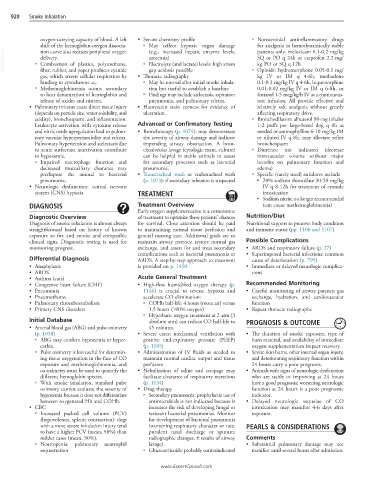Page 1836 - Cote clinical veterinary advisor dogs and cats 4th
P. 1836
920 Smoke Inhalation
oxygen-carrying capacity of blood. A left • Serum chemistry profile ○ Nonsteroidal antiinflammatory drugs
shift of the hemoglobin-oxygen dissocia- ○ May reflect hypoxic organ damage for analgesia in hemodynamically stable
VetBooks.ir ○ Combustion of plastics, polyurethane, ○ Electrolyte (and lactate) levels: high anion SQ or PO q 24h or carprofen 2.2 mg/
tion curve also reduces peripheral oxygen
(e.g., increased hepatic enzyme levels,
patients only: meloxicam 0.1-0.2 mg/kg
delivery.
azotemia)
kg PO or SQ q 12h
gap acidosis possible
fiber, rubber, and paper produces cyanide
kg IV or IM q 4-6h, methadone
gas, which arrests cellular respiration by • Thoracic radiography ○ Opioids: hydromorphone 0.05-0.1 mg/
binding to cytochrome a 3 . ○ May be normal after initial smoke inhala- 0.1-0.3 mg/kg IV q 4-6h, buprenorphine
○ Methemoglobinemia occurs secondary tion but useful to establish a baseline 0.01-0.02 mg/kg IV or IM q 6-8h, or
to heat denaturation of hemoglobin and ○ Findings may include atelectasis, aspiration fentanyl 1-5 mcg/kg/h IV as a continuous-
release of oxides and nitrites. pneumonia, and pulmonary edema. rate infusion. All provide effective and
• Pulmonary irritants cause direct tissue injury • Fluorescein stain corneas for evidence of relatively safe analgesia without greatly
(depends on particle size, water solubility, and ulceration. affecting respiratory drive.
acidity), bronchospasm, and inflammation. ○ Bronchodilators: albuterol 90-mg inhaler
Leukocyte activation with cytokine release Advanced or Confirmatory Testing 1-2 puffs per large-breed dog q 8h as
and nitric oxide upregulation lead to pulmo- • Bronchoscopy (p. 1074): may demonstrate needed or aminophylline 6-10 mg/kg IM
nary vascular hyperpermeability and edema. the severity of airway damage and indicate or diluted IV q 8h, may alleviate reflex
Pulmonary hypertension and atelectasis due impending airway obstruction. A bron- bronchospasm
to acute surfactant inactivation contribute choalveolar lavage (cytologic exam, culture) ○ Diuretics: not indicated (decrease
to hypoxemia. can be helpful in stable animals to assess intravascular volume without major
○ Impaired macrophage function and for secondary processes such as bacterial benefits on pulmonary function and
decreased mucociliary clearance may pneumonia. edema)
predispose the animal to bacterial • Transtracheal wash or endotracheal wash ○ Specific (rarely used) antidotes include
pneumonia. (p. 1073): if secondary infection is suspected ■ 20% sodium thiosulfate 30-50 mg/kg
• Neurologic dysfunction: central nervous IV q 8-12h for treatment of cyanide
system (CNS) hypoxia TREATMENT intoxication
■ Sodium nitrite no longer recommended
DIAGNOSIS Treatment Overview (can cause methemoglobinemia)
Early oxygen supplementation is a cornerstone
Diagnostic Overview of treatment to optimize these patients’ chances Nutrition/Diet
Diagnosis of smoke inhalation is almost always for survival. Close attention should be paid Nutritional support to preserve body condition
straightforward based on history of known to maintaining normal tissue perfusion and and immune status (pp. 1106 and 1107)
exposure to fire and smoke and compatible general nursing care. Additional goals are to
clinical signs. Diagnostic testing is used for maintain airway patency, restore normal gas Possible Complications
monitoring progress. exchange, and assess for and treat secondary • ARDS and respiratory failure (p. 27)
complications such as bacterial pneumonia or • Superimposed bacterial infections: common
Differential Diagnosis ARDS. A step-by-step approach to treatment cause of deterioration (p. 795)
• Anaphylaxis is provided on p. 1450. • Immediate or delayed neurologic complica-
• ARDS tions
• Asthma (cats) Acute General Treatment
• Congestive heart failure (CHF) • High-flow humidified oxygen therapy (p. Recommended Monitoring
• Pneumonia 1146) is crucial to reverse hypoxia and • Careful monitoring of airway patency, gas
• Pneumothorax accelerate CO elimination: exchange, hydration, and cardiovascular
• Pulmonary thromboembolism ○ COHb half-life: 4 hours (room air) versus function
• Primary CNS disorders 1.5 hours (100% oxygen) • Repeat thoracic radiographs
○ Hyperbaric oxygen treatment at 2 atm (3
Initial Database absolute atm) can reduce CO half-life to PROGNOSIS & OUTCOME
• Arterial blood gas (ABG) and pulse oximetry 45 minutes.
(p. 1058) • Severe cases: mechanical ventilation with • The duration of smoke exposure, type of
○ ABG may confirm hypoxemia or hyper- positive end-expiratory pressure (PEEP) burn material, and availability of immediate
carbia. (p. 1185) oxygen supplementation impact recovery.
○ Pulse oximetry is less useful for determin- • Administration of IV fluids as needed to • Severe skin burns, other internal organ injury,
ing tissue oxygenation in the face of CO maintain normal cardiac output and tissue and deteriorating respiratory function within
exposure and methemoglobinemia, and perfusion 24 hours carry a poor prognosis.
co-oximetry must be used to quantify the • Nebulization of saline and coupage may • Animals with signs of neurologic dysfunction
different hemoglobin species. facilitate clearance of respiratory secretions who are stable or improving at 24 hours
○ With smoke inhalation, standard pulse (p. 1134) have a good prognosis; worsening neurologic
oximetry cannot evaluate the severity of • Drug therapy function at 24 hours is a poor prognostic
hypoxemia because it does not differentiate ○ Secondary pneumonia: prophylactic use of indicator.
between oxygenated Hb and COHb. antimicrobials is not indicated because it • Delayed neurologic sequelae of CO
• CBC increases the risk of developing fungal or intoxication may manifest 4-6 days after
○ Increased packed cell volume (PCV) resistant bacterial pneumonias. Monitor exposure.
(hypovolemia, splenic contraction): dogs for development of bacterial pneumonia
with a more severe inhalation injury tend (worsening respiratory character or rate, PEARLS & CONSIDERATIONS
to have a higher PCV (mean, 58%) than purulent nasal discharge or sputum;
milder cases (mean, 50%). radiographic changes, ± results of airway Comments
○ Neutropenia: pulmonary neutrophil lavage). • Substantial pulmonary damage may not
sequestration ○ Glucocorticoids: probably contraindicated manifest until several hours after admission.
www.ExpertConsult.com

